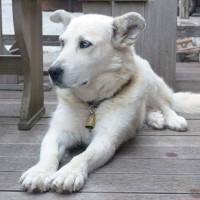Appearance of the Pyrenees Husky
|
| The Pyrenees Husky is a blend of the two parent breeds. It's a medium to large dog. It will have the thick coat of its parent breeds, but its coloring will vary. It may be white throughout, or it may have the black markings of the Siberian Husky. These markings can also be gray. His muzzle is generally long and his nose is black. Their eyes may be blue, like the parent Siberian Husky breed. They may also be amber in color. Ears may be erect like the parent Siberian Husky, or they may be floppy like the parent Pyrenean Mountain Dog. If the latter, you'll need to pay close attention to the ears when grooming. He'll probably have long hair and a thick, waterproof double coat. |
Temperament of the Pyrenees Husky
|
| The Pyrenees Husky is a highly intelligent, affectionate dog. However, they are hard workers at heart and need to be active enough not to become destructive. While Pyrenean Mountain Dogs are more docile, the Siberian Husky can become destructive when bored. The hybrid's tendencies will depend on the most dominant parent breed. He will be a little difficult to train, but perseverance is the key. The Pyrenees Husky can sometimes be rebellious. They are not suitable for inexperienced dog owners. Some experts recommend obedience training for the breed. Be aware that they can wander. Another tip: the Pyrenees Husky can get out of its collar and can easily break the attachment chains. You'll need to plan for this if you decide to acquire a Pyrenees Husky. |
Needs and activities of the Pyrenees Husky
|
| The Pyrenees Husky is a fairly active dog. He's also very inquisitive and, when left to his own devices, will dig or jump over fences less than 1.80 meters high to get out and explore. To keep him from getting bored, take him on hikes, long jogs around the neighborhood and, if you have suitable outdoor space, allow him to spend time outdoors. Again, remember that he's proving to be a bit of an escape artist, so only place him in a fenced-in area that he can't get out of or dig into. Outings to the dog park should only take place after obedience training. He tends to wander, but an older, more mature Pyrenees Husky will be more likely to settle down and enjoy the dog park. Although built for the outdoors, he's happiest indoors with his family. |
Maintenance of the Pyrenees Husky
|
| The Pyrenees Husky will require a lot of maintenance. It will have a thick double coat that requires weekly brushing to prevent matting. Not only will he shed throughout the year, but he'll also blow his coat twice a year. In spring and autumn, brush him daily to avoid excessive hairiness on your clothes and furniture. Depending on the type of ear he inherits, you may also need to pay special attention to his ears. If he inherits the floppy ears of the Pyrenean Mountain Dog parent, you'll need to clean his ears weekly with a cotton ball and lukewarm water. Be sure to check for foul odors and redness, as these indicate infection. Brush her teeth two or three times a week to prevent tartar build-up and bad breath. However, to prevent tooth decay, brush daily. Trim his nails every two or three weeks if they don't wear down on their own. |









 English (United Kingdom)
English (United Kingdom)